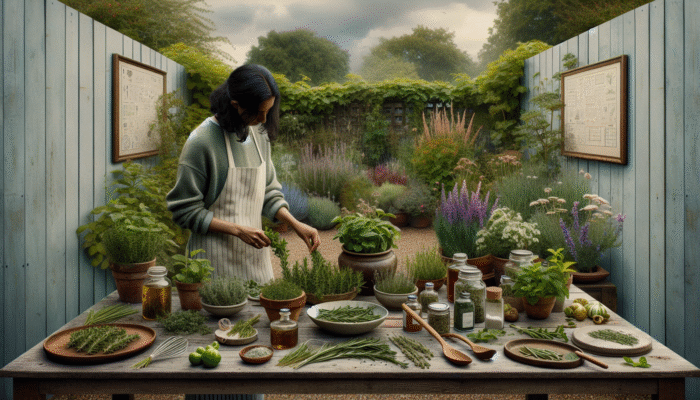Exploring the Rich Herbal Traditions of the UK: A Historical Perspective
Discover the Deep Historical Roots of Herbal Practices

Crafting Custom Herbal Blends: The heritage of herbal practices in the United Kingdom is a tapestry woven from ancient traditions, where the utilization of herbs played a pivotal role in healing and daily existence. The Druidic customs of the Celtic people revered specific plants for their mystical qualities and restorative abilities. This reverence continued into the medieval period, wherein herbal remedies became crucial to healthcare practices. Influential texts like *Bald’s Leechbook*, created by ancient Anglo-Saxons, provide extensive documentation on local flora and their medicinal uses. The Renaissance marked a resurgence of interest in herbalism, prominently featuring figures like Nicholas Culpeper, who advocated for the incorporation of indigenous herbs into healing methodologies.
In contemporary times, the essence of these ancient practices continues to thrive within diverse communities throughout the UK, often harmoniously merging with modern wellness ideologies. Today’s herbalists are committed to safeguarding these time-honored traditions, enriching them with contemporary insights into health and wellness. By harnessing local herbs, they champion sustainability and strengthen the bond between individuals and their natural surroundings. Understanding this historical framework is essential for anyone aspiring to create personalized herbal blends that pay homage to these rich traditions.
Delving into the Diverse Range of Herbs Found in the UK
The United Kingdom boasts a myriad of climates and ecosystems, each nurturing a unique assortment of herbs that offer a vast array of therapeutic and culinary advantages. In the rugged highlands of Scotland, you will discover heather and bog myrtle, both celebrated for their cleansing and purifying properties. Conversely, the southern coastal areas benefit from a Mediterranean climate that encourages the flourishing of vibrant herbs like rosemary and thyme, which thrive under warm sunlight.
In the enchanting woodlands of Wales, wild garlic flourishes during spring, blanketing the forest floor with its presence, offering exciting culinary possibilities along with significant health benefits, including its antimicrobial properties. The eastern regions of England are renowned for their abundant chamomile, recognized for its calming and soothing effects. By familiarizing yourself with these regional herbal varieties, you can craft distinctive blends that encapsulate the essence of the UK’s rich botanical heritage. This knowledge is paramount for anyone looking to blend herbs effectively and sustainably.
Understanding the Cultural Importance of Herbs in British Society
In the UK, herbs occupy a significant place within cultural history, often intertwined with folklore and traditional practices. An example of this is the ancient custom surrounding the use of St. John’s Wort during the summer solstice, reflecting a long-held belief in its protective and healing qualities. Local festivities, such as the annual Herb Festival in the Cotswolds, celebrate these plants, highlighting their historical and medicinal significance.
Moreover, various communities possess their own unique herbal lore, with stories and traditions handed down through generations that enrich the blending process. Gaining insight into these cultural narratives allows individuals to connect with the profound meanings behind the herbs they choose. The symbolism associated with certain herbs, such as using rosemary for memory and remembrance, infuses custom blends with layers of significance, transforming each creation into a rich narrative encapsulated in every bottle.
Choosing the Ideal Herbs for Your Custom Blends in the UK

Identifying Popular Herbs Commonly Used in the UK
To create bespoke herbal blends, it is essential to become acquainted with the commonly used herbs throughout the UK. Among the most favored choices, mint flourishes in gardens and hedgerows, offering a refreshing aroma that is perfect for both culinary and medicinal applications. Another vital herb, nettle, often overlooked, is packed with health benefits, including anti-inflammatory properties and a rich nutrient profile.
Thyme is cherished for its versatility in the kitchen, enhancing the flavor of countless dishes while also functioning as a powerful antiseptic. Additionally, the distinctive aroma of rosemary not only elevates savory meals but is also historically linked to improved memory and cognitive function. By selecting these herbs, individuals embark on an exciting journey into the world of custom blends tailored to their unique tastes and health objectives.
Gaining Insight into the Seasonal Availability of Herbs
Understanding the seasonal availability of herbs is crucial for those eager to create personalized blends. The UK experiences distinct seasons, each offering a specific selection of herbs. In the invigorating spring, herbs like chives and wild garlic emerge, making them ideal for refreshing blends. The summer months unveil a plethora of flavors, with herbs such as basil and dill reaching their peak, perfect for enhancing salads and dressings.
As autumn arrives, heartier herbs like sage and thyme take center stage, delivering grounding flavors suitable for comforting, warming dishes. While winter may appear to lack fresh herbs, dried varieties like oregano and rosemary can still be effectively incorporated into blends. By being aware of these seasonal transitions, you can create herbal blends that not only delight the palate but also adhere to sustainable practices and the natural rhythms of the environment.
Locating High-Quality Herbs for Your Custom Blends

Acquiring high-quality herbs is fundamental for developing effective herbal blends. Local farmers’ markets present excellent opportunities to discover fresh, organic herbs that are often at their flavor and potency peak. Additionally, herbal apothecaries and specialty shops often provide dried herbs that are ethically sourced and expertly crafted.
Engaging with local herb growers can also offer invaluable insights into specific herb varieties and their optimal uses, enriching the blending experience. When sourcing herbs, it is vital to take into account factors such as sustainability and organic practices to ensure that the herbs positively influence both individual health and the well-being of the planet. By prioritizing quality ingredients, you can significantly enhance the effectiveness and enjoyment of your herbal concoctions.
Growing Your Own Herbs for Personalized Blends
Growing your herbs is one of the most rewarding ways to ensure a steady supply of fresh ingredients for your custom blends. The UK’s climate is conducive to cultivating a wide variety of herbs, making home gardening both practical and enjoyable. Start with a modest selection like basil, parsley, and mint, which are relatively easy to grow and thrive well in pots or garden beds.
The quality of soil plays a critical role in herb cultivation; incorporating compost can enhance nutrient availability and support healthy growth. Adequate sunlight is another vital factor, as most herbs require at least six hours of direct sunlight each day. Thus, selecting a sunny spot in your garden or utilizing a windowsill can be beneficial. Indoor gardening also offers a viable alternative, especially for those with limited outdoor space. With attentive care, homegrown herbs provide a continuous supply of fresh ingredients, perfect for crafting delightful custom blends.
Preserving Herbs for Year-Round Enjoyment
Preserving herbs is crucial for maintaining their flavor and aroma throughout the year, enabling you to enjoy the benefits of your homegrown or sourced herbs long after the growing season has concluded. Drying is one of the most popular preservation techniques, with methods ranging from air drying to utilizing a dehydrator. Air drying is straightforward and involves suspending herbs upside down in a dark, well-ventilated area until they are thoroughly dry.
Freezing is another effective preservation method, particularly for herbs such as basil and mint. By chopping the herbs and placing them in ice cube trays filled with water or oil, you can easily freeze them for later use in soups and stews. Proper storage is critical; ensure that herbs are kept in airtight containers away from light and humidity to maintain their potency. By mastering these preservation techniques, you can ensure a consistent supply of high-quality herbs for your custom blends throughout the year.
Advanced Strategies for Blending UK Herbs
Achieving Balanced Flavors in Your Herbal Blends
Creating harmonious herbal blends necessitates a nuanced comprehension of various flavor profiles. Each herb possesses distinct characteristics—some are bold and pungent, while others are subtle and delicate. The secret to successful blending lies in achieving a balanced flavor profile, ensuring that no single herb overpowers the others. For instance, pairing robust rosemary with milder herbs like parsley can yield a well-rounded blend.
Experimentation with proportions is essential for crafting unique blends. Begin with small batches, adjusting the ratios to align with your taste preferences. Continuously tasting during the blending process will help you identify the right balance and allow for prompt modifications. Incorporating complementary flavors can elevate the overall blend; for example, combining herbs that share similar aromatic compounds can enhance synergy within the mixture. Ultimately, mastering the art of balancing flavors is crucial for developing unique custom blends that are delightful to the palate and effective for their intended purposes.
Mastering Drying and Storage Techniques for Herbs
Becoming proficient in drying and storing herbs is fundamental for preserving their potency and flavor. After harvesting, ensure that herbs are washed and thoroughly dried to prevent mold growth during storage. Various techniques can be utilized for drying, including air drying, oven drying, or dehydrating. Air drying, the most traditional method, involves bundling herbs together and hanging them in a dark, cool location with good airflow.
Once dried, herbs should be stored in airtight containers, preferably glass jars, and kept in a cool, dark environment. Labeling containers with the name of the herb and the date of drying helps track freshness. Dried herbs can lose potency over time; therefore, it is crucial to regularly check for aroma and flavor. By implementing these drying and storage techniques, you can ensure that your herbal blends maintain their vibrant characteristics and deliver optimal benefits.
Understanding Mixing Ratios for Effective Herbal Blends
Mastering the ideal mixing ratios is essential for creating successful herbal blends. Each herb brings unique properties to the table, and understanding how to balance these elements can lead to a more harmonious outcome. A general guideline suggests using a base herb that comprises 50% of the blend, complemented by supporting herbs at 25% each. This ratio lays a solid foundation while allowing the distinctive qualities of each herb to shine through.
When determining ratios, consider the intended application of your blend; for instance, if crafting a blend aimed at digestive health, herbs known for their digestive benefits, such as peppermint and ginger, may warrant higher proportions. Conversely, more pungent herbs like sage should be used sparingly. Experimentation is key; keeping detailed notes on each blend you create, including the ratios and observed effects, empowers you to refine your approach over time. Mastering mixing ratios will elevate your herbal blending skills, enhancing the effectiveness of your custom formulations.
Unlocking Health Benefits Through UK Herbal Blends
Formulating Herbal Blends to Support Digestive Health
Creating herbal blends that promote digestive wellness is both beneficial and rewarding. Herbs like peppermint, recognized for their ability to ease bloating and indigestion, serve as excellent ingredients in a soothing blend. Additionally, including ginger can enhance digestive function and stimulate appetite, making it a valuable addition to any digestive blend.
Fennel seeds are another fantastic herb frequently used to relieve gas and discomfort. When crafting a digestive blend, consider combining these herbs in equal parts to achieve a balanced profile or adjusting according to personal taste preferences. Brewing these blended herbs into a tea can be particularly effective, allowing for the gentle extraction of their health benefits. By focusing on digestive wellness, you can create blends that not only please the palate but also significantly enhance overall health.
Creating Herbal Blends to Enhance Immune Function
With an increasing focus on immune health, crafting herbal blends designed to bolster the immune system is a timely endeavor. Elderberry stands out as a key ingredient, celebrated for its antiviral properties and rich antioxidant content. When paired with echinacea, this blend further enhances immune function, as echinacea is renowned for stimulating the body’s natural defense mechanisms.
Moreover, consider incorporating thyme for its antimicrobial properties and vitamin C-rich herbs like lemon balm. The blend should be thoughtfully crafted, with elderberry as the primary ingredient, supported by equal parts of the other herbs. Infusing these herbs into syrups, tinctures, or teas can amplify their effectiveness, providing an enjoyable and impactful way to support immune health. By prioritizing immune support in your blending journey, you will create a collection of powerful mixes that can be enjoyed throughout the year.
Designing Herbal Blends for Stress Relief and Relaxation
In our fast-paced world, crafting herbal blends aimed at alleviating stress is increasingly sought after. Herbs such as chamomile, renowned for their calming properties, serve as an excellent foundation for these blends. Lavender also stands out, cherished for its soothing aroma and ability to promote relaxation.
Combining these calming herbs with valerian root can enhance the blend’s effectiveness, as valerian is commonly used to reduce anxiety and improve sleep quality. When combining these herbs, consider a 3:1 ratio of chamomile to lavender, followed by a smaller portion of valerian, to create a soothing and balanced mix. These blends can be enjoyed as teas or added to bath infusions, providing a holistic approach to stress relief. By focusing on stress-relieving properties, your custom blends will offer much-needed respite in daily life.
Exploring Culinary Uses for UK Herbal Blends
Crafting Savory Herbal Blends to Elevate Culinary Flavors
Herbs play a vital role in enhancing the flavors of savory dishes, and creating custom blends can dramatically elevate your culinary creations. A classic herb blend in UK cuisine combines thyme, rosemary, and sage, making it perfect for seasoning roasted meats and vegetables. These herbs complement each other beautifully, with thyme’s earthy notes harmonizing with rosemary’s robust flavor and sage’s slightly peppery essence.
For a Mediterranean flair, consider blending basil, oregano, and parsley. This combination shines in pasta sauces and pizza toppings, delivering a burst of flavor that transports you to sun-kissed coastlines. Experimenting with proportions to suit personal tastes is encouraged; feel free to add a pinch of salt or lemon zest to amplify the natural flavors of your blends. The versatility of culinary herbal blends can transform ordinary meals into extraordinary gastronomic experiences.
Creating Delightful Sweet Herbal Blends for Desserts
Unleashing the potential of herbs in sweet dishes reveals a world of flavor possibilities. A delightful combination is mint and chocolate, perfect for desserts like brownies or mousses. Another popular blend features lavender, which can add a floral note to baked goods, pairing beautifully with honey or lemon.
For a refreshing summer beverage, blending basil with strawberries creates an invigorating flavor profile that can be adapted for smoothies and cocktails. When determining ratios, remember to enhance sweetness; for instance, using more strawberries than basil will ensure the blend remains enjoyable. By exploring sweet herbal blends, you’ll discover innovative ways to elevate desserts and beverages, delighting both your guests and your palate.
Crafting Marinades and Rubs Using Herbal Ingredients
Herbal blends are ideal for creating marinades and rubs that infuse meats and vegetables with rich flavors. A robust mixture of garlic, rosemary, and thyme serves as an excellent marinade for lamb, enhancing its natural richness. A blend of lemon zest, oregano, and parsley imparts freshness and brightness to chicken dishes.
Creating a spice rub can yield equally delicious outcomes; combining smoked paprika, cumin, and coriander with fresh herbs adds delightful depth to meat dishes. The key is to allow sufficient marinating time—at least a few hours or overnight for maximum flavor infusion. Customizing these blends to suit your flavor preferences will enhance your culinary creations, ensuring that each meal is memorable and inviting.
Infusing Oils and Vinegars with Herbal Flavors
Infusing oils and vinegars with herbs is an elegant method for adding a gourmet touch to everyday meals. A classic combination is garlic and rosemary-infused olive oil, perfect for drizzling over roasted vegetables or artisan bread. To achieve this infusion, combine the herbs with oil and allow them to steep for several weeks, ensuring the flavors meld beautifully.
Consider blending herbs like tarragon or thyme with white wine or apple cider vinegar for a fresh twist. This infusion process not only enhances flavor but also increases the health benefits of the vinegar. Incorporating these infused oils and vinegars into dressings or marinades will add depth and character to your meals. Embracing the art of infusion broadens your repertoire of herbal blends, enriching your culinary experience.
Understanding Safety and Legal Regulations for Herbal Blends in the UK
Navigating the Regulatory Landscape for Herbal Products
Understanding the regulations pertaining to herbal blends in the UK is essential for ensuring safety and compliance. The Food Standards Agency (FSA) provides comprehensive guidelines on the safe utilization of herbs and herbal products, safeguarding consumers. Herbalists and enthusiasts must stay informed about the legal requirements regarding the sale and distribution of herbal blends.
Herbal products intended for medicinal use may also fall under the jurisdiction of the Medicines and Healthcare Products Regulatory Agency (MHRA). Adhering to these regulations ensures that products are safe for consumers, minimizing potential health risks. Additionally, understanding the regulatory framework fosters ethical practices within the herbal community, building trust and transparency between consumers and suppliers.
Following Safe Dosage Guidelines When Utilizing Herbs
Adhering to safe dosage guidelines is crucial when developing and using herbal blends. Each herb comes with its recommended dosage, and exceeding these amounts can result in adverse effects. For instance, while chamomile is generally considered safe, excessive consumption may lead to unwanted side effects such as nausea.
It is advisable to consult reputable sources or qualified herbalists when determining dosages, particularly for individuals with pre-existing health conditions or those currently on medication. Crafting blends with a focus on moderation will optimize their effectiveness and minimize risks associated with overconsumption. By being diligent about safe dosages, you can fully enjoy the benefits of your herbal blends without compromising your health.
Prioritizing Allergen Awareness in Herbal Blending
Being aware of common allergens present in herbs is essential for ensuring safety in your custom blends. Many individuals may have sensitivities or allergies to specific herbs, especially those belonging to the Asteraceae family, including chamomile and echinacea. Recognizing these potential allergens allows you to create blends that cater to a variety of dietary needs.
Clear labeling is crucial when sharing or selling your herbal blends. Including a comprehensive list of ingredients and potential allergens ensures that consumers can make informed decisions. Additionally, educating yourself about cross-reactivity among herbs can enhance safety measures. By prioritizing allergen awareness, you’ll contribute to a more inclusive and safe environment for all herbal blend enthusiasts.
Engaging in UK Herbal Workshops and Educational Programs
Finding Local Herbal Workshops and Events
Participating in herbal workshops and courses throughout the UK provides a fantastic opportunity to deepen your understanding and skills in herbal blending. Numerous organizations and herbalists offer hands-on experiences suited to individuals of all expertise levels. From foundational classes covering herbalism basics to advanced workshops focusing on specialized topics, there is a wealth of options available.
Local community centers, botanical gardens, and herbal societies frequently host these workshops, creating opportunities to connect with like-minded individuals. Additionally, online platforms have emerged, offering virtual workshops that reach a wider audience. Engaging in these educational experiences not only enhances your blending techniques but also nurtures a sense of community and connection to the expansive world of herbs.
Learning from Experienced Herbal Practitioners
Learning from seasoned herbalists and practitioners can profoundly enrich your herbal blending journey. Many workshops are led by experts who share their extensive knowledge and passion for herbs, providing insights that extend beyond the basics. These instructors often weave in personal stories, historical applications, and modern practices, creating a learning experience that is both relatable and engaging.
Consider seeking mentorship opportunities with local herbalists or attending informative talks and seminars hosted by experienced professionals. The knowledge gained from these interactions can guide your blending practices and deepen your understanding of the herbal landscape in the UK. By tapping into the wisdom of experts, you can accelerate your journey toward becoming a skilled and knowledgeable herbal blender.
Gaining Practical Experience in Herbal Blending
Acquiring hands-on experience in creating herbal blends is invaluable for anyone serious about herbalism. Many workshops offer practical activities, enabling participants to experiment with various herbs, explore blending techniques, and develop custom blends. This experiential learning fosters confidence and enhances understanding of how different herbs interact.
Additionally, participating in group activities encourages discussions about preferences, techniques, and challenges faced by fellow herbal enthusiasts. This collaborative atmosphere promotes the sharing of ideas and nurtures creativity. By immersing yourself in hands-on experiences, you’ll refine your skills and cultivate a deeper appreciation for the art of herbal blending.
Sharing Your Unique UK Herbal Blends with the Community
Building Community Connections Through Herbal Sharing
Sharing your herbal blends with local communities fosters connections and inspires others to explore the world of herbs. Consider organizing workshops, pop-up events, or community gatherings where you can demonstrate blending techniques and showcase your creations. Local farmers’ markets are excellent venues for presenting your blends, enabling direct customer interaction and allowing you to share your passion for herbs.
Collaborating with local wellness centers, cafes, or shops can broaden your reach, creating opportunities to introduce your blends to a wider audience. Encouraging feedback from the community will assist in refining your blends and cultivating a supportive network of herbal enthusiasts. By actively participating in community sharing, you’ll contribute to a culture of appreciation and education surrounding herbs.
Utilizing Online Platforms to Share Your Herbal Creations
Leveraging UK-based online platforms is a strategic approach for sharing and selling your herbal blends. Websites like Etsy or local online marketplaces allow you to reach a broader audience while showcasing your unique offerings. Building an online presence through social media can foster engagement and connect you with individuals who share similar interests.
Creating informative content, such as blog posts or videos detailing your blending process, can enhance your visibility and attract potential customers. Sharing your knowledge and experiences establishes credibility and positions you as a trusted source in the herbal community. By effectively utilizing online platforms, you can significantly expand your reach and share your herbal blends with a global audience.
Embracing Feedback for Continuous Improvement
Gathering feedback from users of your herbal blends is vital for ongoing enhancement. Encourage customers to share their experiences and insights through reviews or direct communication. This dialogue can provide invaluable information regarding taste preferences, effectiveness, and potential areas for improvement.
Utilizing this feedback to iterate on your blends demonstrates a commitment to quality and customer satisfaction. Regularly revisiting and adjusting your recipes based on user experiences not only improves your products but also strengthens customer loyalty. By fostering a culture of feedback and continuous improvement, you’ll ensure that your herbal blends resonate with those who use them.
Frequently Asked Questions About Herbal Blending
Which herbs are ideal for beginners in herbal blending?
Beginners should consider starting with herbs like basil, mint, and parsley, as they are easy to cultivate and versatile in culinary applications. These herbs can also be utilized in simple blends to explore various flavor combinations.
Is it acceptable to substitute dried herbs for fresh ones in recipes?
Yes, dried herbs can replace fresh ones; however, keep in mind that dried herbs are more concentrated. Adjust the quantities accordingly—generally, one part dried herb is equivalent to three parts fresh herb.
How can I verify the safety of my herbs for use?
Research the properties of each herb and consult reputable herbal resources or professionals. It is essential to check for known allergies and understand safe dosages for the herbs you intend to use.
What are the most effective methods for preserving herbs?
The best preservation techniques for herbs include drying, freezing, or creating infused oils and vinegars. Each method helps maintain the flavor and potency of herbs for future use.
Are there particular herbs I should approach with caution?
Certain herbs, such as St. John’s Wort or comfrey, may interact with medications or possess contraindications. Always consult a healthcare professional before using new herbs, especially if you are pregnant or taking medication.
Can I legally sell my herbal blends in the UK?
Yes, you can sell your herbal blends, but you must comply with UK regulations regarding the sale of food products. Proper labeling and adherence to safety guidelines are essential for legal compliance.
How do I achieve a balanced herbal blend?
Begin by selecting a base herb and then introduce supporting herbs in smaller proportions. Experiment with different ratios and tastes to achieve a harmonious blend.
What are some common uses for herbal blends?
Herbal blends can be utilized in teas, culinary dishes, marinades, skincare, and medicinal applications. Their versatility makes them suitable for various purposes, enhancing flavor and health benefits.
Where can I expand my knowledge about herbalism?
Consider attending workshops, reading literature from herbal experts, or joining local societies. Online resources, webinars, and courses are excellent avenues for broadening your understanding.
What tools are essential for blending herbs?
Basic tools include a mortar and pestle or spice grinder for grinding herbs, measuring spoons for accuracy, and airtight containers for storage. A precise scale can also help achieve accurate measurements.
Connect with us on Facebook!
The Article: How to Create Custom Herbal Blends: A UK Guide appeared first on https://mcrtherapies.co.uk
The Article Custom Herbal Blends: Your Essential Guide for the UK Was Found On https://limitsofstrategy.com

